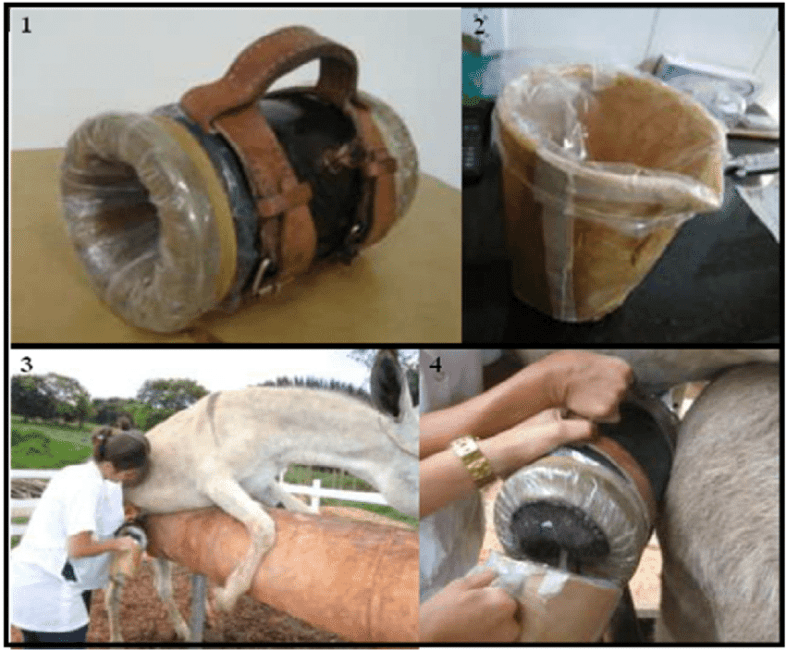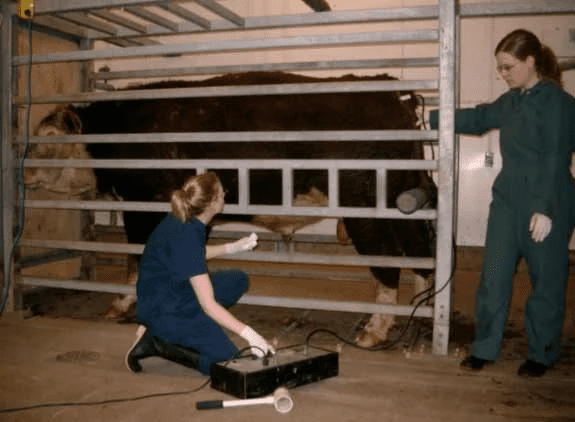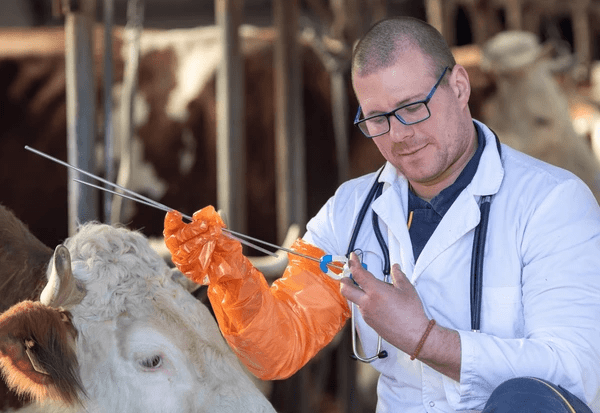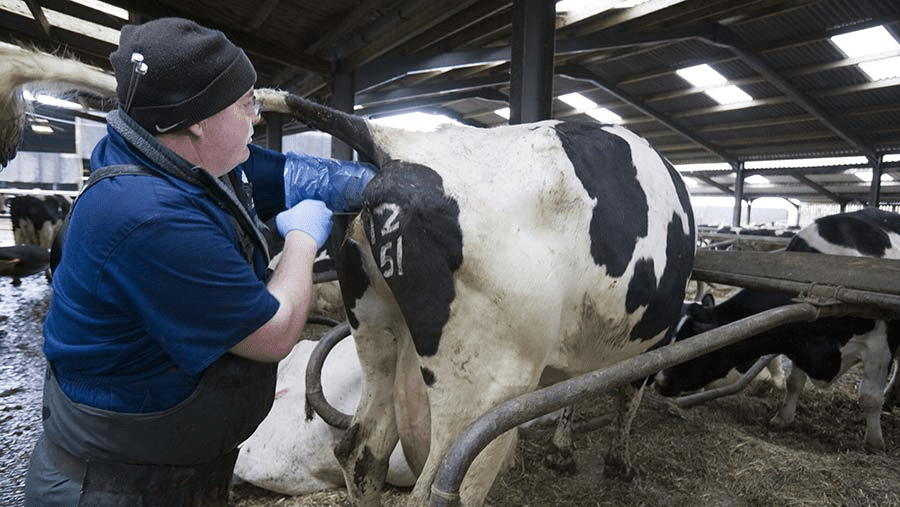Artificial insemination (AI) is a preferred method for introducing superior genes from individuals that are free from specific diseases, which helps improve the production of offspring. AI is also beneficial for breeding animals outside their natural breeding seasons, especially after inducing and synchronizing oestrus through photoperiod manipulation or hormone use.
This technique allows for adequate milk production and evens out labour needs throughout the year. Semen used for out-of-season breeding can be frozen or stored as a liquid, especially when collected from ducks, rams, and cattle kept under artificial light to mimic the shorter days of their natural breeding season.
Although higher pregnancy rates can be achieved with trans-abdominal insemination compared to cervical insemination, the former may be restricted due to ethical concerns.
Read Also: Artificial Insemination Techniques in Animal Breeding
Procedure for Semen Collection Using an Artificial Vagina

Proper preparation is crucial for successful semen collection using an artificial vagina (AV). The standard service routine should be followed:
1. Estrus cows should be placed in the service yard.
2. The bull is restrained as usual and led to the estrus cow. This allows the bull to see and smell the cow before being led away, preventing immediate mounting.
3. This process typically results in the bull becoming fully aroused, enhancing libido.
4. The usual technique involves leading the bull to the cow, with the operator standing to the right of the cow’s hindquarters.
5. The bull will nose the cow’s perineum, depress its back, and make preliminary pumping movements, during which the penis protrudes and accessory secretions are discharged.
6. Mounting then occurs, and the bull makes some thrusting movements with its penis.
7. At this point, the operator grasps the bull’s sheath with their left hand and directs the penis toward the AV, which is held in the operator’s right hand.
8. When the penis contacts the lubricated surface of the AV, vigorous ejaculation usually occurs.
9. The AV, initially held horizontally, is then held upright to allow the ejaculate to flow into a graduated tube.
If the bull’s fertility is being tested, at least three semen samples should be collected. Bulls should be handled gently during semen collection; shouting or beating should be avoided. The entire process should be conducted quietly.
The Use of an Electroejaculator

Electroejaculators are commonly used to collect semen from young bulls for evaluation at AI centers. A modified electric current is delivered through electrodes set into a metal probe, which is inserted into the bull’s rectum and positioned over the ampullae.
The stimulation is applied in increasing waves, starting with low voltage and then raising to 15-20 volts, eventually causing semen to drip from the penis. The semen collected through this method tends to be more valuable.
Rectal Massage
This technique involves inserting a lubricated hand and arm into the bull’s rectum to locate the seminal vesicles, which are then stroked against the penis, causing accessory fluids to drip from the sheath hairs.
The ampullae are located, if possible, between the fingers and thumb. If this method fails, a stroke toward the urethra may be attempted. However, a drawback of this technique is that the samples obtained may not be representative of the true ejaculate.
Advantages of AI
1. AI allows for the widespread use of a top-quality sire, enabling more females to be inseminated across a wide area without moving the sire.
2. It eliminates the cost and risk associated with maintaining a sire for a small herd or flock, making it easier to use desirable, proven-quality sires.
3. AI helps prevent the spread of certain reproductive diseases.
4. It allows for the use of exotic breed bulls, which might otherwise be difficult to maintain in harsh environments.
5. Improved record-keeping is possible, as exact conception dates can be known.
6. AI can be well-coordinated with estrus synchronization programs.
7. It helps eliminate size differences between sires and dams.
8. Semen from sires can be used for several years, even after the sire has died, which is beneficial for research programs.
9. Bull sterility can be easily detected.
10. AI is generally quicker than natural mating.
Disadvantages of AI
1. AI requires trained personnel.
2. The equipment needed can be costly or inaccessible to local farmers.
3. The behavior of indigenous animals, especially cattle, makes AI difficult to practice. Heat detection is challenging, and indigenous bulls may not easily mount or ejaculate using an artificial vagina.
4. Poor infrastructure can make it difficult to supply or perform AI.
5. Extensive use of AI may reduce the market for bulls.
6. Using poor or dirty equipment can cause diseases or infections in the dams.
7. Inseminating a female that is not in estrus can lead to permanent sterility, metritis, abortion, fetal death, or maternal illness.
8. If a bull with undesirable traits is used for AI, these traits may become widespread, taking time to eliminate.
Read Also: Natural Mating vs Artificial Insemination: Find out which is Better
Preparation of a Slide for Estimating Sperm Mortality

All surfaces that will come into contact with semen should be clean and sterile, including the glass slide, cover glass, and glass rod.
Steps:
1. Warm the slide carefully, ensuring it does not become too hot.
2. Place one drop of warm (38°C) physiological saline (0.9g NaCl in 100ml distilled water) or sodium citrate buffer (Na₃C₆H₇.2H₂O) on the pre-warmed slide.
3. Gently invert the tube of raw semen 2 or 3 times and place a very small amount of semen in the saline or citrate buffer. If the semen has been diluted, saline or citrate buffer may not be necessary.
Diluents or Extenders for Liquid Semen
Fresh semen can be used for insemination within 24 hours of collection without dilution if stored properly. However, to be used successfully in AI, semen should be diluted at least 4 times its volume with diluents or extenders, and its fertility must be retained for at least 4 days.
Special diluents or extenders have been developed to provide a buffer to maintain a constant pH and to supply nutrients and antibiotics. The most commonly used diluents include:
A. Egg Yolk Citrate Diluent
1. Dissolve 2.9g of crystalline sodium citrate in 180ml of double-distilled water.
2. Wash fresh eggs obtained from a disease-free flock, soak them in 70% alcohol for 5 minutes, then dry them before breaking the shells.
3. Using aseptic precautions, separate the egg yolk from the albumen as completely as possible, puncture the yolk membrane, and collect the yolk in a stainless-steel container.
4. To mix 100ml of diluent, combine 20ml of egg yolk and 80ml of sodium citrate buffer solution.
5. Some workers use a higher proportion of yolk to citrate than the 1:4 ratio, up to equal parts of the two ingredients.
B. Boiled Skimmed Milk Diluent
1. Adequate heating of milk is required to destroy lactenin, a factor toxic to sperm. Use fresh homogenized pasteurized milk or fresh pasteurized skimmed milk from a reliable creamery.
2. Avoid fresh skimmed milk fortified with milk solids. Homogenized milk containing vitamin D or activated ergosterol is acceptable.
3. Using an accurate thermometer, heat the milk to 92°-95°C and hold it at this temperature for 10 minutes in a covered glass double boiler or a covered vessel placed directly on a heated plate.
4. Cool the milk to room temperature, add the required level of antibiotics, and store at 5°C until ready for use. It is usually prepared a day before use.
C. Milk Glycerol Diluent
1. Dilute the semen to one-half the final sperm concentration with fresh, previously heated, and cooled skim milk or homogenized milk containing antibiotics.
2. Cool the partially diluted semen slowly to 5°C over a period of 4 hours.
3. Add an equal volume of cooled milk diluent containing 20% glycerol by volume. For best sperm viability, add the milk glycerol fraction gradually as follows:
- Add in steps: 20%, 30%, and 50% of the milk at 10-minute intervals.
- Add in three equal volumes at 10-minute intervals.
- Add drop by drop from a separatory funnel continuously over 30 minutes.
The final concentration of glycerol should be 10%, and the diluent is ready for pouring into test tubes and packaging for shipment. Equilibration is not necessary.
In summary, artificial insemination (AI) is beneficial for breeding animals outside their natural breeding seasons and can enhance milk production and labor efficiency. The process involves collecting semen using methods like an artificial vagina, electroejaculation, or rectal massage, with careful handling to ensure success.
AI offers numerous advantages, including widespread use of top-quality sires, disease prevention, and improved record-keeping, but it requires trained personnel and proper equipment, which may be costly and challenging in certain environments.
While AI can reduce the need for maintaining sires and offers flexibility in breeding programs, it also presents challenges, such as the potential spread of undesirable traits and the risk of disease from improper techniques. Additionally, semen must be carefully handled and stored, often using specialized diluents or extenders to maintain fertility.
Read Also: List of Problems Confronting Livestock Production

